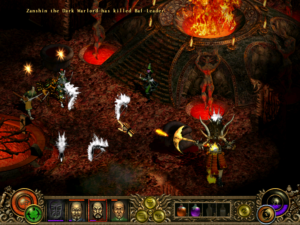Heimdall: Combat
It suddenly strikes me that Heimdall, as an RPG with realtime movement and isometric perspective, could be seen as anticipating Diablo. It took me this long to notice this because it doesn’t play like Diablo at all. Core to Diablo is the lack of separation between exploration and combat: monsters chase you around the map, attacks take place in the same realtime system as movement. That’s not the case here. Exploration is realtime, and combat is realtime, but they’re different realtimes.
As in Desktop Dungeons, all encounters are bound to fixed locations, and involve only one enemy. Sometimes you can see the enemy just standing there waiting, usually blocking a passageway. Other times, it’s a surprise: you’re walking down an empty corridor and you’re suddenly told that a monster has snuck up behind you. As with the pit traps, I can’t really see the surprise encounters as helping the game. For one thing, they’re only a surprise the first time, and I’ve been tending to go through a lot of the islands multiple times, due to not having the right keys to get to the best treasures the first time. I may even need to replay from the beginning soon: a possibly-essential item seems to have vanished from my inventory, whether through glitch or careless click.
Although you have six characters in your crew, you can only take three of them at a time ashore, and only one at a time can fight. (These vikings clearly get their ideas about battle from kung fu movies.) Combat is mainly a matter of clicking the on-screen “attack” or “defend” buttons at opportune moments. An animated illustration of the enemy takes swings at you and sometimes dodges. You can watch this to time your actions, but frankly, I don’t think I do significantly better by this approach than by just mashing “attack”.
But then, sometimes pressing the “attack” button doesn’t do anything. I’m halfway to convincing myself that only the text of the word “attack”, rather than the whole area of the button, is clickable. If true, horrible! I know that my earliest attempts at attacking failed simply because I hadn’t selected a weapon yet. This is something you have to do at the beginning of every fight; the game has no memory of what you’re wielding, and no notion of a default weapon, even if you’re carrying only one. Fortunately, every combat starts with a “Do you want to run away?” prompt that can be answered with a Y or N from the keyboard. This gives me an opportunity to position my mouse over where I know the button for my weapon will appear, so that I can save valuable seconds at the very beginning. And it’s kind of terrible that the game has me thinking like that.
 Comments(2)
Comments(2)